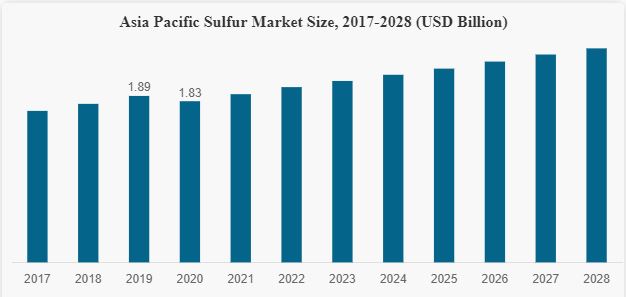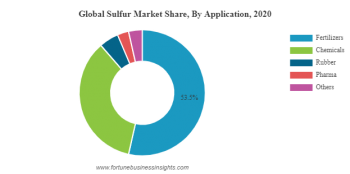
Sulfur Market Size, Share & COVID-19 Impact Analysis, By Application (Fertilizers, Chemicals, Rubber, Pharma) and Regional Forecast(2021-2028)
KEY MARKET INSIGHTS
The global sulfur market size was USD 5.40 billion in 2020. The market is projected to grow from USD 5.61 billion in 2021 to USD 6.98 billion in 2028 at a CAR of 3.2% during the 2021-2028 period. The global impact of COVID-19 has been unprecedented and staggering, with product witnessing a negative impact on demand across all regions amid the pandemic. Based on our analysis, the global market exhibited a decline of 3.72% in 2020 as compared to the average year-on-year growth during 2017-2019. The sudden decline in CAR is attributable to this market’s demand and growth, returning to pre-pandemic levels once the pandemic is over.
One of the most essential raw ingredients in the chemical industry is sulfur. It is mostly utilized as a derivative (in acid form) in various chemical and industrial processes, and it is especially essential in the production of phosphate fertilizers, which is its single greatest end application. Rubber processing, cosmetics, and medicinal applications are important areas of applications. It is a commodity of considerable interest due to its relevance to industrial economies and relative ease of transportation. Petroleum refining, tar sands recovery, heavy oil and natural gas processing, as well as coking and metallurgical facilities, all produce it as a by-product.
Sulfuric acid (H2S04), a significant derivative, is one of the most important materials utilized in base industries. As a result, it is one of the most essential industrial elements. Mostly, companies use the Frasch process for mining.
COVID-19 IMPACT
Disruptions in Import Activities due to COVID-19 Cause Negative Effect on Market.
Attributed to the impact of the coronavirus pandemic on refinery output, liquid sulfur supply remained limited. Supply was also impacted by ongoing causes such as a shift to sweeter crude, plant turnarounds, and the continuing depletion of output from German natural gas sources. Chinese purchasers restricted their imports. In May 2021, China bought little under 500,000 tons. This was the lowest level of imports in May since 2004 and a 16% decrease over May 2020. Import activity in India was also stifled due to COVID-19 regulations.
The fertilizer industry has been impacted since the beginning, especially in China, which is the world’s largest producer and user of phosphates, and acid. In future, Brazil and India are expected to become the front runners. The pandemic in China had the most significant impact on the Chinese fertilizer industry to date, impacting fertilizer transportation and quality.
LATEST TRENDS
Establishment of Many Sulfur Recovery Plants is the latest Trend.
Majority of the product is utilized in the form of acids. This acid is a key intermediate in a variety of industrial & chemical processes. The fertilizer business uses the acid to make nitrogen, phosphates, potassium, & sulfate fertilizers. Pigments, hydrofluoric acid, non-ferrous metals, cosmetics, fibers, carbon disulfide, medicines, personal care products, rubber vulcanization, and steel pickling are some of the applications.
Reduced natural gas processing, a shift in feedstock mixtures from sour to somewhat sweet oil, depletion of particular natural gas sources, and changes in demand from specific types of fuel have all had an impact on the output during the last five years. However, new facilities in the Middle East and mainland China’s developing coal chemical sector, which has created rigorous environmental requirements, have led to the development of several recovery plants and boosted production by 8%.
DRIVING FACTORS
Increasing Demand for Fertilizers to Propel Market Growth.
Plants utilize nitrogen, phosphorus, potassium, sulfur, calcium, and magnesium in comparatively considerable quantities. Nutrients are lost from the environment due to crop removal, erosion, leaching, soil fixation, and other factors. Thsi is particularly necessary throughout the early stages of development for the production of vital amino acids, proteins, and oils. Its most important role in crop production is to aid in the creation of protein molecules and amino acids, which are necessary for the production of chlorophyll, lignin, and pectin. It accomplishes this by assisting photosynthesis, which is the process by which plants transform sunlight into chemical energy. Agricultural fertilizer production accounts for about 54% percent of all recovered product generated globally.
The fertilizer market is not only a large business but also an important sector that supports world food production.
Without intensive agriculture and fertilizer use, this amount of output would not be conceivable. The main end-market for fertilizers is grains, followed by cash crops, including vegetables, fruit, flowers, and vines. Increased fertilizer use is mostly driven by population and economic growth. Production must keep up with constant growth in consumption.
With the growing global population, demand will continue to rise in future. Food costs must eventually be high enough to stimulate investment and production expansion. Elemental sulfur is widely utilized in industries, primarily for the manufacture of H2 SO4, with a large percentage of the acid used in fertilizer production.
According to, the world fertilizer outlook, demand for phosphorus (POs) fertilizer in 2020 was estimated at 47,402 thousand tons, which is expected to reach 49,096 thousand tons in 2022.
RESTRAINING FACTORS
Adverse Reaction on Exposure May Hamper Market Growth.
SO2 is a sulfur-oxygen gas that pollutes the atmosphere. When fuels such as coal, oil, or diesel are burnt, 502 is produced. According to the U.S. Environmental Protection Agency, man-made sources in the U.S. released about 6.4 million tons of SO2. Electricity production, industrial boilers, and other industrial operations such as petroleum refining and metal processing are the major sources of SO2 emissions. Old buses and vehicles, locomotives, ships, and off-road diesel equipment are all important sources of diesel engines. People who live and work near these major sources are the ones who are exposed to most SO2. When SO2 is released into the air, it converts to sulfate particles, which may travel hundreds of miles. Continued high-level exposure worsens respiratory symptoms and decreases the lungs’ ability to function. Breathing via the lips, as well as rapid breathing during exercise, promotes $02 to reach the lower respiratory tract. This is expected to hamper the market growth.

SEGMENTATION
Fertilizers Segment to Hold a Significant Share Due to Population Growth.
In terms of application, the market is segmented into fertilizers, chemicals, rubber, pharma, and others. The fertilizers segment constituted more than 50% of market share. Sulfuric acid is made from around 90-95% of the elemental sulfur collected. This has become more popular as a nutrient in recent years due to ammonium phosphate derivatives and fertilizers. Fertilizers are the final destination for roughly half of the world’s output. The manufacture of phosphate fertilizers accounts for roughly 85% of the total while ammonium sulfate production is also substantial. As a result, this industry is highly reliant on the worldwide phosphate fertilizer business, which is cyclical.
The product is used in agriculture as a plant nutrient, but it is also used as an intermediary in the manufacture of phosphoric acid, and thus as phosphate fertilizers. Almost all the elements are used to make H2SO4, which is the most commonly used inorganic chemical on the planet and is utilized in a variety of industrial and metallurgical operations as well as agricultural applications.
REGIONAL INSIGHTS
Asia Pacific held the largest sulfur market share in global market and is expected to continue its dominance by the end of forecast period. The region stood at USD 1.83 billion in 2020. Increasing demand for sulfur-based fertilizers from agricultural countries, such as India, China, Japan, and Kazakhstan, is expected to boost the demand. For instance, according to the World Fertilizer Magazine, in 2020, the overall fertilizer consumption of India was 61.4 million tons.
Increasing demand for food grains and agricultural produce, owing to the growing population is anticipated to propel the market growth.
The Middle East & Africa holds significant share in the market, owing to the large manufacturing base present in Gulf countries. It is a major by-product of oil refineries. Large number of oil refining and gas processing companies is expected to fuel the market growth. Additionally, high demand from rubber industry is one of the major factors influencing regional growth.
North America will show considerable growth attributed to the growing demand for the acid from end-use industries, including chemical, pharmaceutical, and metal extraction. Growing mining activities will aid the market growth. Predominant use in metal extraction and purification activities is expected to register high demand.
Europe is expected to show significant growth by the end of the forecast period. High demand from end-use industries is key factor influencing growth in the region. Large consumer base for chemicals and subsequently increasing demand are surging the product demand.
Latin America is expected to register moderate growth due to large-scale mining activities. Developing economic and social conditions of South American countries, such as Brazil, Colombia, Argentina, Mexico and others, are boosting the market growth.

